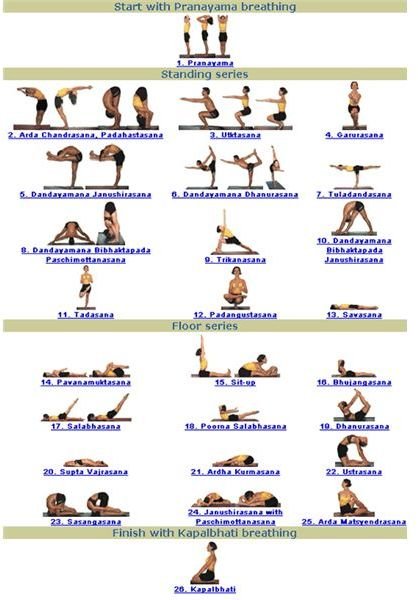The 26 Bikram Yoga Poses
Who Invented Bikram Yoga?
Bikram Yoga was created by Bikram Choudhury, a well-known Indian Yoga master. He founded Bikram’s Yoga College of India in Los Angeles, where he teaches the practice. In fact, Choudhury has a US Patent on Bikram Yoga and instructors are required to become certified before they can teach it.
About the Postures
Bikram Yoga uses a group of 26 postures, which are ideally performed in a room at 105 degrees Fahrenheit. During a class, each pose is generally held for a certain amount of time and then repeated.
Bikram Yoga sessions begin with the standing postures. They then move on to backbend postures, then to forward bends and finally to twists.
Each pose is performed while using a directed deep breathing technique called Kapalabhati breathing. Kapalabhati breathing is supposed to help to purify the nasal passage and lungs. It is performed by using a series of quick, forceful exhales which are followed by slower and more natural inhales. Kapalabhati means “cleaning breath.”
Getting Specific: The 26 Bikram Yoga Postures
The twenty-six postures are always completed in a very specific order, as follows:
1. Pranayama Series (Standing Deep Breathing)
2. Ardha Chandrasana with Pada-Hastasana (Half Moon Posture, Hands to Feet Posture concurrently)
3. Utkatasana Awkward Posture
4. Garudasana Eagle Posture
5. Dandayamana-JanuShirasana (Standing Head to Knee Posture)
6. Dandayamana-Dhanurasana (Standing Bow Pulling Posture)
7. Tuladandasana (Balancing Stick Posture)
8. Dandayamana-Bibhaktapada-Paschimottanasana (Standing Separate Leg Stretch Posture)
9. Trikonasana (Triangle Posture)
10. Dandayamana-Bibhaktapada-Janushirasana (Standing Separate, Leg/Head to Knee Posture)
11. Tadasana (Tree Posture)
12. Padangustasana (Toe Stand Posture)
13. Savasana (Dead Body Posture)
14. Pavanamuktasana (Wind Removing Posture)
15. Sit up Posture
16. Bhujangasana (Cobra Posture)
17. Salabhasana (Locust Posture)
18. Poorna-Salabhsana (Full Locust Posture)
19. Dhanurasana (Bow Posture)
20. Supta-Vajrasana (Fixed Firm Posture)
21. Ardha-Kurmasana (Half Tortoise Posture)
22. Ustrasana (Camel Posture)
23. Sasangasana (Rabbit Posture)
24. Janushirasana with Paschimottanasana (Head to Knee Posture, Stretching posture concurrently)
25. Ardha-Natsyendrasana (Spine Twisting Posture)
26. Khapalbhati (Deep breathing)
Things to Consider
As with any form of exercise, be sure to check with your doctor before beginning a Bikram Yoga regimen. Pregnant women should not perform this type of yoga at all, because the elevated temperatures (in addition to the work-out itself) can raise the body’s core temperature, possibly harming the fetus. Be aware that most practitioners of Bikram Yoga attend class wearing as little clothing as possible since it is so hot. Always bring your own mat and supplies to classes. Since Bikram Yoga causes the body to sweat so much, it isn’t sanitary to share equipment.
